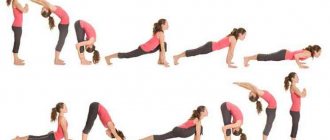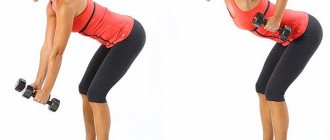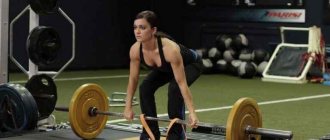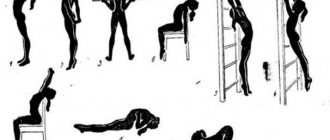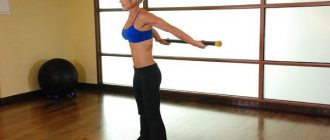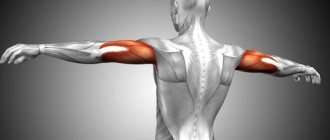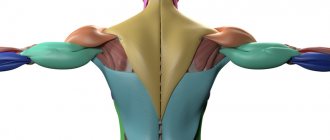Exercises without stress on the spine: how to do it correctly
A complex system, the most important part of the body, the spine, needs training like no other.
The condition of the spine is decisive for many processes and the operation of almost all systems. It is necessary to train the back muscles, but not everyone can load the spine.
Therefore, there are special programs consisting of exercises that do not put stress on the spine.
Exercises without stress on the spine
How to strengthen your spine
The spinal cord is located here, the nerve pathways are concentrated, and a significant part of the autonomic system passes through. Being a structural unit of the general nervous apparatus, the autonomic one works autonomously. Its activity is not controlled by willpower and does not depend on human consciousness. At the same time, many life processes taking place in the body depend on its normal operation.
By the way. The health of the spine and the spinal cord located in it is the precise functioning of all internal organs. If the spinal structure is disturbed, the vertebrae are displaced, the discs are worn out, the nerve endings are pinched and do not conduct impulses to the organs, disrupting the order of their work.
Spinal cord
Unfortunately, many people of different ages, gender and social status are familiar with spinal problems.
Disturbances of the natural vertebral structure occur for the following reasons:
- injuries;
- hypothermia;
- diseases;
- pathological formation;
- psychological problems;
- weakened muscle corset.
Due to injuries and physical inactivity, natural disorders of the spinal structure may occur.
If a person can influence the first five reasons relatively, then the last one, in the case when it is not associated with the natural aging process, is subject to correction with the help of exercises.
Five tips from doctors on how to strengthen your back and protect your spine from damage.
- Limit any traumatic exposure.
- Avoid hypothermia, try not to find yourself in situations of long-term exposure to cold and drafts.
To avoid hypothermia, you should use wool belts for the lower back. - Watch your posture.
- Experience less stress and pay due attention to emotional and psychological relief.
Try to be less stressed - Stimulate blood flow and strengthen the back muscles.
It is entirely humanly possible to complete all these points, but for the latter you will have to work hard, since the strengthening of the spinal muscles and the speed of blood flow is achieved only by constant and correct exercises.
With or without load
Everyone needs to exercise. Even during the treatment of serious diseases of the spine, even after surgery on the spinal column, therapeutic exercises are prescribed. When performing it, there are special restrictions, exercises are selected individually, but without gymnastics there is no effective therapeutic or rehabilitation complex.
Performing individually selected exercises is beneficial for each person
Moreover, gymnastics is indicated for people who have problems with the spine in the initial stages, and for the prevention of many spinal diseases. But there is one important point - with or without load. This question is very important, especially if you decide to train your back on your own, without coordinating the exercises with a doctor or trainer.
There are two global types into which exercises of all groups are divided:
- With axial load.
- Without carrying out a load.
If the spine is in a healthy condition, exercises in which the spine is maximally involved and a noticeable load is placed on it must be included in the training program in order to fully pump up the muscles of the back and other parts of the body. But with existing spinal pathologies or a predisposition to them, axial load exercises are prohibited. You can only perform complexes without load.
https://youtu.be/_el_HJqTs24
For existing back pathologies, exercises without stress on the spine are recommended.
For what problems should axial load exercises not be performed?
Degenerative changes in the spine are the number one problem worldwide. Osteochondrosis has ceased to be a disease of older people; every day this disease is becoming “younger”. Hernias and protrusions are the main complication of osteochondrosis. We recommend reading the article on our website to learn everything about the symptoms, differences and methods of treating protrusions and herniated intervertebral discs.
That is, it turns out that if there is a problem with the spine, you cannot load it. But not everything is so simple, since problems come in varying degrees of severity, and for this, all exercises are subject to a more flexible classification, according to which the load can be:
- strong;
- moderate strength;
- specific;
- static.
Table. Types of axial load exercises.
Load typeGroups of exercises
| Strong | Almost all manipulations with a barbell and some of the exercises using dumbbells, in which the weight falls on the shoulders or arms with an amplitude tilt of the body. |
| Moderate | It affects the spine indirectly if the weight is in the hands without significant tilt of the body. |
| Specific | Basically, abdominal exercises, during which there is no direct impact on the spinal column, but the vertebrae may experience stress from a certain body position. |
| Static | With this type of load, the weight affects the vertebrae without changing the angle of the back, which is in a static position, which has a compensatory effect. |
Important! Many exercises can put pressure on the spine, even simple walking. But if the doctor recommends an absolute limitation of loads, then nothing from the table above can be performed, and if the limitation is not complete, only positions that give a strong load on the axle are removed.
People who regularly train, but due to problems with the spine are not able to continue training with the usual load, are offered to replace the exercises with a complex with a minimal load.
- If you have a medical condition, you should consult your doctor before performing even non-weight-bearing or minimally weight-bearing exercises.
Get advice from your doctor about the need and possibility of doing exercises. - If you are shown limiting the axial load, all load-bearing exercises are excluded for six months.
- If the restriction is incomplete, exercises with the heaviest load are removed from the training program.
- When limited, to reduce the axial load force, reduce the weight of the rod to 20 kg.
do not forget to take into account the weight of the bar if you are training with a barbell
To reduce the load that falls on the spine in everyday life, you must adhere to the following rules.
- In any situation, watch your posture and keep your back straight.
Control it. A hunched back causes serious disc and vertebral problems in the future. Watch your posture - Sit correctly and evenly at a table in the office, at home, or at the computer. Make sure that the height of the furniture is adjusted to your height.
- If you carry out most of your activities while sitting, get up more often, stretch your muscles, and learn to relax them.
Warm up often - For long journeys in a sitting position or if you spend a lot of time driving, use orthopedic seat pads under your back or a pillow.
- If you wear a backpack frequently, do not overload it, or purchase a special backpack with a spinal support function.
Do not overload backpacks and bags - Never carry heavy objects in one hand, and do not lift objects that are too heavy, even with both hands.
- Provide complete comfort and relaxation to your back and neck while you sleep.
How to choose the perfect pillow - Regularly train your back muscles by doing exercises for different parts of the spine and training your muscle corset, and also strengthen your abdominal muscles.
- If you experience the slightest discomfort in your back, consult a doctor, and also pay attention to the prevention of spinal diseases.
Prevention of back diseases - During exercises, especially strength ones, observe the execution technique.
A set of exercises without spinal load
This complex is recommended for restoring the spine and increasing the mobility of all its segments. The main rule is a slow pace and smooth execution - no sudden movements. You need to perform the whole complex at once every day.
Exercise one
Starting position - on all fours. Lower your buttocks onto your heels, pressing them tightly. Then stretch your body forward, bending back and arching your body, moving your head back. Repeat twelve times. You need to do the movements slowly, increasing the amplitude.
https://youtu.be/dFFTU6wqSLs
Exercise one
Exercise two
The starting position is the same. Chin up, knees touching each other. Raise your shins at an acute angle and turn them from side to side. At the same time, the shoulder and body rotate towards the hip. While breathing spontaneously, repeat slowly twelve times.
Exercise two
Exercise three
From a position on all fours, lower your pelvis smoothly, first in one direction, and then, after returning to the starting position, in the other. In this case, the knees, shins and feet are pressed tightly to the floor.
Exercise three
Exercise four
Same starting position. The back is bent downwards, the head is raised up and thrown back. Then the back arches upward, touching the chin to the chest and rounding the shoulders. The hips and pelvis occupy a static position.
Exercise four
Exercise five
Lying on your back, bend your knees, placing your feet on the floor. Extend your arms along your body. Press your shoulder blades to the floor. Turn your joined knees, trying not to separate them, in one direction or the other, touching them to the floor. Do not lift your back from the floor.
Exercise five
Exercise six
From the same lying position, extend your legs at will. Raise one knee and use your hands to pull it towards your stomach. Change leg. Then bend your legs and pull both legs towards your stomach at the same time, helping with your arms.
Exercise six
Exercise seven
Get on all fours, straighten your body, focusing on your hands and knees. Perform push-ups, leaning on your knees, working with your arms and shoulder girdle. Socks on the floor. The back is aligned. Try to touch the floor with your chest. If your physical fitness allows, you can put your feet on your toes and focus on them.
Exercise seven
Performing these exercises will not allow the disease to progress, and in the absence of spinal pathologies, it will be an excellent prevention of their occurrence. If you are engaged in strength training, if you have problems with the spine, use the recommendations of doctors to reduce the axial load and replace the load exercises with analogues with a minimum load.
– Exercises without stress on the spine
Source: https://spina-expert.ru/simptomy/uprazhneniya-bez-nagruzki-na-pozvonochnik/
In what cases is special physical education indicated?
Strong, trained vertebral muscles securely hold the entire human skeleton, and the muscles of the lumbar spine are responsible for the condition of half of its bones.
For those who are forced - due to lifestyle or professional necessity - to lead a sedentary lifestyle, the lumbar muscles weaken, and there is a need to strengthen them and return them to normal tone. If pain of any kind appears after performing the exercises, the exercises should be stopped for a while.
https://youtu.be/Qucbgogmz-o
Active physical education is contraindicated:
- during pregnancy;
- after recent spinal column injuries.
Exercises with axial load on the spine
What are exercises with axial load on the spine? This question is most often asked by people who have problems with the spine. If you have spinal osteochondrosis, kyphosis, scoliosis, intervertebral hernia or other back injury, then exercises with axial load on the spine are contraindicated for you. What are these exercises and what can you replace them with? Read further in this article.
Exercises with an axial load on the spine are those exercises in which the weight of the weight presses and compresses the spine along its axis, that is, creates an axial load on the spine.
Now let's look at what exercises create an axial load on the spine and what exercises without axial load can replace them. For convenience, the exercises will be divided into main muscle groups.
Exercises for legs with axial load on the spine
- Squats with a barbell on your shoulders
- Front Squats
- Smith machine squats
- Hack squats with barbell
- Deadlift on straight legs
- Bend forward with a barbell on your shoulders
- Lunges with a barbell
- Standing calf raises
Exercises for legs without axial load on the spine
- Leg press in the simulator
- Leg extensions in the simulator
- Lying leg curls in the simulator
- Calf raise while sitting in the machine
Back exercises with axial load on the spine
- Barbell deadlift
- Deadlift with dumbbells
- Shrugs with a barbell
- Shrugs with dumbbells
- Bent-over barbell row
- Bent-over T-bar row
Exercises for the back without axial load on the spine
- Row-T bar in a machine with a chest support
- Upper pulley to chest
- Pull-down of the upper block behind the head
- Seated row of block to the waist
- Bent-over dumbbell row
- Wide grip pull-ups
CHEST MUSCLES
When performing exercises for the pectoral muscles, an axial load is not created on the spine. Therefore, you can perform almost all exercises for the chest. The main thing is to adhere to the correct technique and listen to how you feel.
Biceps exercises with axial load on the spine
- Standing biceps curl
- Standing dumbbell curl
- Standing reverse grip barbell curl
- Biceps exercises without axial load on the spine
- Scott Bench Curls
- Lifting dumbbells for biceps while sitting on an incline bench
- Concentrated dumbbell curls for biceps
Triceps exercises with axial load on the spine
- Standing French barbell press
- Standing overhead dumbbell press
- Triceps exercises without axial load on the spine
- Close grip bench press
- French bench press
- Dips
- Bench push-ups
- Standing arm extensions on a block
Shoulder exercises with axial load on the spine
- Standing chest press
- Standing overhead barbell press
- Standing Dumbbell Press
- Barbell row to the chin
Shoulder exercises without axial load on the spine
In order to reduce the load on the spine when performing shoulder exercises, it is enough to use a bench with a backrest. The angle of inclination of the back of the bench should be 70-80 degrees.
- Bench press sitting on a bench with a backrest
- Dumbbell press while sitting on a bench with a backrest
- Swing dumbbells to the sides while sitting on a bench with a backrest
- Raising arms to the sides on the simulator
NOTES
1. If you have back diseases or injuries, be sure to consult with your sports physician.
With a complete limitation of axial loads, it will be necessary to exclude all exercises with axial load on the spine for at least 6 months.
If the restriction is partial, then you can remove only those exercises that create the strongest axial load on the spine (barbell squats, deadlifts, etc.).
2. If you have no contraindications for exercising in the gym, do not be afraid of exercises with axial load. It is important to understand that these are mainly basic exercises that are the most effective for gaining muscle mass and strength. The main thing is to always adhere to the correct exercise technique and gradually increase the working weights.
3. The force of the axial load on the spine very much depends on the weight of the burden. For example, squats with a barbell weighing 20 kg will not create a large axial load on the spine.
Source: https://gsport.org/sportivnye-stati/item/osevaya-nagruzka-na-pozvonochnik
For what diseases is it limited and why?
Axial loads have a greater impact on the lower limbs.
The joints of the lower extremities suffer the most from axial load. This is due to constant pressure when walking, which causes rapid wear of the working surfaces and a decrease in the amount of intra-articular fluid. This, in combination with other factors, is the cause of arthritis, arthrosis and coxarthrosis. The hip joint is most susceptible to pathological effects. Including a strong axial load on the knee joint is contraindicated. Therefore, exercise therapy complexes associated with lifting weights in a plane parallel to the axis of the body are prohibited. Any exercises should not cause the development of pain; they can be performed only during the period when the symptoms of the disease subside. The load increases gradually. This will help properly prepare the body for future stress. After all, over time a person becomes more trained.
Effective exercises without stress on the spine
Problems with the spine act as a limitation that prohibits the performance of certain types of exercises. Ignoring warnings is fraught with exacerbation of the disease, so exercise must be approached responsibly. The program should include exercises that do not place significant stress on the back.
The importance of selecting exercises
The human body is forced to constantly resist the forces of gravity, and every day the spine experiences significant loads. As a result of various degenerative processes, osteochondrosis often develops, which can lead to more serious problems in the form of disc protrusion, hernias and other pathologies.
Axial loads cause significant harm to the supporting system, so doctors and trainers recommend that people with spinal problems avoid such exercises. This category includes activities with heavy sports equipment in a standing or bending position. It is necessary to exclude:
· squats;
· deadlifts and bench presses of heavy weights;
· tilts with weights.
https://youtu.be/C5_aInErvnU
Preference should be given to exercises performed lying down, on all fours or in a sitting position. You can use light weight dumbbells and expanders, and the right choice of complex will strengthen your back muscles and prevent spinal diseases.
Rules for drawing up a program
Any workout should begin with a warm-up to warm up the muscles and reduce the risk of injury. The optimal frequency of exercise is 2-3 times a week with a break a day, since the body needs time to rest and recover.
Leg exercises
Some of the most effective exercises for training leg muscles include squats and leg raises. Technique:
· leg spread - lie on your back, focus on your arms and shoulder blades extended along the body, with your pelvis raised, stretch the expander and stretch your hips again;
· squats with a fitness band - place the equipment at hip level, stand straight and place your feet shoulder-width apart, slowly move your pelvis back and perform squats, keeping your hands locked in front;
· squats with a lunge - put one leg back and squat into a lunge, returning to the starting position.
The expander provides great opportunities for training the muscles of the legs and buttocks. It allows you to increase resistance during movement, which increases the effectiveness of your workouts.
Working on the chest and abdominal muscles
Push-ups are considered the leader among all chest exercises. They allow you to simultaneously use your arms, legs, and strengthen your back and abs. Depending on your level of preparation, you can use the following options:
· wide placement of hands;
· narrow enough;
· slow fast pace;
· performing with clapping.
To avoid unnecessary stress on the back, it is important to avoid arching in the lower back. If there are contraindications, it is recommended to replace classical exercises with wall push-ups.
A classic or dynamic plank gives a good effect of strengthening the back muscles. The first is to ensure a straight line of the body, when the main emphasis is on the arms and tips of the feet. The hold can be performed on the palm with straightened arms or on the elbow bones. With a dynamic plank, the legs are included in the work, which are alternately pulled up to the stomach.
Crunches are considered effective exercises for the abs. In case of back problems, it is recommended to work with the upper body. With this option, only the shoulder blades come off the floor, and the lower part remains motionless.
Exercises with dumbbells
Exercises with dumbbells are optimal for women, people without sufficient physical fitness or with health restrictions. Pulling with light weights perfectly strengthens the back muscles. Technique:
· stand up straight and place your feet shoulder-width apart, take dumbbells in your hands;
· tilt your body forward slightly, ensuring a natural arch in the lower back;
· lower your arms and, using the bend of your elbows, pull the equipment to waist level;
· return to the starting position and repeat the cycle up to 15 times.
Placing dumbbells behind the head is considered effective for training the muscles of the chest and arms.
Exercise for back problems is performed lying on your back, which ensures minimal stress on the vertebrae and reduces the risk of exacerbation. The dumbbells rise up and are slowly wound behind the head.
The movement stops when it reaches 5 cm from the floor level, after which the hands return to their original position.
If discomfort or pain occurs during exercise, it is recommended to pay attention to the technique and postpone the exercise. It is important to start training with a small number of repetitions, giving the muscles time to rest and recover.
Source: https://zen.yandex.ru/media/id/5c4e4df4570db000ae5b1b32/effektivnye-uprajneniia-bez-nagruzki-na-pozvonochnik-5e7b568cf59c597ec4f45604
Is it possible to exercise in the gym after a spinal injury?
Greetings dear readers. I would like to note right away that the further narration in this article will be on behalf of our regular reader Daniel.
Any athlete, beginner or professional, can suffer an accident when he receives a serious injury. From my personal experience, I want to say health is above all, value and take care of it.
Training for a spinal fracture
A year ago I was in a car accident and received a comminuted compression fracture of the 12th thoracic vertebra . Before the injury, my experience in the gym was about 10 years.
Naturally, after the operation, the doctor forbade me from lifting anything heavier than 5 kg. I felt crushed during this period, but over time I came to terms with it. A year after the operation, in order to at least somehow not lose shape, I started going swimming, but my soul demanded something completely different.
The soul demanded iron. And the search for literature on this subject began.
https://youtu.be/VHyoNxWRgIM
Products from our store
Having thoroughly understood the scientific materials on this topic, I realized that this injury is not a death sentence, and I will still be able to engage in fitness, only with restrictions .
I would like to note that it is not unimportant that you are observed by your attending physician and visit him periodically to monitor your health status. Without control and a clear understanding of the severity of your injury, doing anything is very dangerous. First, recover enough so that further training does not worsen your situation.
Training program for spinal injury
Once you have an idea of the degree and state of damage to the body, you must create a competent training program for yourself so as not to worsen your health.
For example, if your shoulder is damaged, then you need to remove all exercises on the damaged joint (ligament or bone), that is, all presses.
Everything is extremely individual, and first of all you must listen to your feelings and your body.
In my case, a year after the injury, I finally persuaded the doctor to start my workouts in the gym. The doctor gave permission, but with the condition - lifting heavy objects without axial load on the spine. Although this excluded about half of the exercises, I was still able to choose the optimal training program for all muscle groups and returned to my favorite activity.
Products from our store
I'll break down my training program for each muscle group. The combination will be standard: chest + biceps, back + triceps, legs + shoulders. Once or twice a week I also train my abs with any muscle group.
Chest training for spinal injury
I didn’t encounter any particular problems with the chest, since all the loads on the spine are “dumped” onto the bench . My chest workout example:
1) Bench press on an inclined bench (20 degrees) – 4 x 12-15.
2) Dumbbell bench press on an inclined bench (30 degrees) – 4 x 12-15.
3) Raising dumbbells to the sides while lying on a bench – 4 x 15.
Biceps/triceps training for spinal injury
On a chest day, I add two or three more exercises for either biceps or triceps. The main difference is that I do all exercises for biceps or triceps either on a regular bench or on a Scott bench . My exercise example:
Biceps:
1) Lifting the barbell for biceps on a Scott bench – 4 x 15-20.
2) Lifting dumbbells for biceps while sitting on a bench (80 degrees) – 4 x 15-20.
Products from our store
Triceps:
1) Bench press with a narrow grip – 4 x 12-15.
2) Arm extension on a block – 4 x 15-20.
3) French press with a dumbbell on a bench (80 degrees) – 4 x 15-20.
Back training for spinal injury
But when training the back, “dancing with a tambourine” has already begun. If before I didn’t bother too much, I did deadlifts and various bent-over rows , but now such exercises are strictly forbidden to me . The main criterion that has now appeared is fixing the back and releasing weight from the spinal axis.
The optimal solution in my case was to use, again, an inclined bench. Before the injury, I did not perform such exercises because there was no need. My back exercises:
1) Barbell row to the lower back while lying on an inclined bench with a curved bar – 4 x 12-15.
2) Pull-ups to the chest (without weight) – 4 x 8-12.
3) Vertical block pull – 4 x 12-15.
4) Hyperextension (without weight) – 3 x 20.
Shoulder training for spinal injury
I can’t do bench presses with my back fully (90 degrees) straightened . Therefore, I set the back of the bench at 75-80 degrees. This maximizes the load on the deltoids, reduces it from the pectoral muscles, and at the same time takes it off the spine.
Products from our store
My shoulder workout example:
1) Incline dumbbell press (80 degrees) – 4 x 10-12.
2) Raising dumbbells to the sides while sitting on a bench – 4 x 12-15.
3) Raising arms in the simulator for the rear delta – 4 x 12-15.
Leg training for spinal injury
Everything about the legs is very sad. All basic exercises have one way or another an axial load on the spine . Classic squats, lunges, front squats. In my case, it became impossible to perform the highest quality exercises for working the legs, so I came up with this solution for myself:
1) Leg press on the machine – 4 x 10-12.
2) Standing squats on platforms with weights (or weights) – 4 x 12-15.
3) Leg bending in the simulator - 3 x 20.
4) Leg extension in the simulator – 3 x 20.
5) Calf raise while sitting in a machine – 3 x 20.
Abdominal training for spinal injury
Abdominal training is also difficult. Classic crunches give me discomfort in my spine when doing them . Therefore, for the abs I perform either a plank (2-3 minutes) or leg raises (reverse crunches - 3 x 15). I do leg raises either with emphasis on my elbows or hanging on a bar.
https://youtu.be/OeuUrUuDvq0
Products from our store
Conclusion
As you can see, even after a serious injury, if you wish, you can choose a training program and perform exercises for your pleasure and body development. Be healthy and take care of yourself. Each case is individual and this article should not be regarded as an application to actions .
about training in the gym after a spinal injury
Source: https://lovelybody.ru/%D0%BC%D0%BE%D0%B6%D0%BD%D0%BE-%D0%BB%D0%B8-%D0%B7%D0%B0%D0 %BD%D0%B8%D0%BC%D0%B0%D1%82%D1%8C%D1%81%D1%8F-%D0%B2-%D0%B7%D0%B0%D0%BB%D0 %B5-%D0%BF%D0%BE%D1%81%D0%BB%D0%B5-%D1%82%D1%80%D0%B0%D0%B2%D0%BC/
Physical education for the lower back while lying down
Lie down on the floor face up, clasp your hands at the back of your head. With your legs relaxed, place your feet shoulder-width apart. Rise and lower the upper half of the body without lifting the lumbar region from the floor. Do 10-30 approaches.
https://youtu.be/rnDWEAmG_10
“Half-bridge” - take the same position as in the first exercise, exhaling, lift your buttocks high from the surface. Exercise provides excellent blood flow to the lumbar muscles. Perform 10-30 times.
Lie face down, bend your arms, rest your palms, keep them in line with your shoulders. Relax. Raise the upper half of the body to the maximum, smoothly extending your arms, trying to stretch your spine so that your waist bends. Stay in the indicated position for 10 seconds, take the original position. Perform 15-20 times.
When finished, relax while lying down and allow your muscles to rest. Then squat down and sit with your buttocks on your calf muscles. Raise your arms, stretch upward, relaxing the spinal column. Do this for 2-3 minutes.
Strength training for a sore back: replacing axial exercises
If you have problems with the spine, then most likely you have wondered about axial loads and exercises related to this.
Unfortunately, many of us have problems associated with the spine, this applies to people suffering from kyphosis, osteochondrosis, intervertebral hernias, scoliosis, etc.
And the question also arises, what kind of workouts can you do so as not to harm, but, on the contrary, to help yourself?
It seems that we found out a long time ago that axial loads are prohibited, but how can we replace the usual exercises with similar ones in effect, but without such a load?
Every day we receive a lot of questions about this, so we decided to write this article and answer the question, what alternatives do exercises with axial load have, what to replace them with?
Let's first figure out what axial loads are.
Axial load exercises and replacements
Exercises with axial load are those exercises in which the spine is compressed along its axis under the influence of the gravity of the projectile.
Now let's look at the most pressing part of the question. What kinds of exercises with axial load are there and how can they be replaced.
Legs
Exercises with axial load:
- Squats with a barbell on your shoulders
- Lunges with a barbell
- Front Squats
- Smith machine squats
- Hack squats with barbell
- Deadlift on straight legs
- Standing calf raises
- Bend forward with a barbell on your shoulders
Exercises without axial load:
- Leg press in the simulator
- Leg extensions in the simulator
- Lying leg curls in the simulator
- Calf raise while sitting in the machine
- Gluteal swings
- Squats with dumbbells (weight between legs)
Back
Exercises with axial load:
- Barbell deadlift
- Deadlift
with dumbbells
- Shrugs with a barbell
- Shrugs with dumbbells
- Bent-over barbell row
- Bent-over T-bar row
Exercises without axial load:
- Row-T bar in a machine with a chest support
- Upper pulley to chest
- Pull-down of the upper block behind the head
- Seated row of block to the waist
- Bent-over dumbbell row
Breast
In the case of training the pectoral muscles, axial loads, as a rule, should not be present.
Biceps
Exercises with axial load:
- Standing biceps curl
- Standing dumbbell curl
- Standing reverse grip barbell curl
Exercises without axial load on the spine:
- Raising the barbell for biceps in the Scott bench
- Lifting dumbbells for biceps while sitting on an incline bench
- Concentrated dumbbell curls for biceps
Triceps
Exercises with axial load:
- Standing French barbell press
- Standing overhead dumbbell press
Triceps exercises without axial load on the spine:
- Close grip bench press
- French bench press
- Dips
- Bench push-ups
- Standing arm extensions on a block
Shoulders
Axial Load Exercises:
- Standing chest press
- Standing overhead barbell press
- Standing Dumbbell Press
- Barbell row to the chin
Exercises without axial load:
To turn an axial exercise into a non-axial one, just use a bench with an adjustable back and set the degree of inclination to approximately 70-80 degrees.
- Bench press sitting on a bench with a backrest
- Dumbbell press while sitting on a bench with a backrest
- Swing dumbbells to the sides while sitting on a bench with a backrest
- Raising arms to the sides on the simulator
How to deal with back pain?
Bone Wide for health and activity, and therefore for movement. Even with a sore back, any physical activity is welcome, but it is important that it is not excessive.
https://youtu.be/09zlld8I33E
Unfortunately, a big mistake is health complexes exclusively with symmetrical exercises, static loads, and also with heavy loads on the back.
When you first experience back pain, you should:
- go to the doctor (neurologist),
- start moving.
Many people immediately go to the pool and in the trailer, and at this moment they reason correctly. Swimming relieves tension, develops the muscles of the shoulder girdle and legs, and forces the back muscles to work in various modes, but without overloading them.
However, few people swim correctly and, instead of treatment, only aggravate their problems . You will learn in detail about how to swim correctly in the article 4 points of the harm of swimming for the head, neck and back: why does the pool not ease the pain for many, but aggravate it?
Remember, the main goal of your sports should be to strengthen the back muscles and restore the symmetry of their structure.
In parallel with sports recovery, it is necessary to work on the nervous system, monitor all internal organs and, if necessary, resort to their treatment.
A very important point: if the pain is very severe, accompanied by swelling and fever, sports and especially the swimming pool are contraindicated for you!
In such cases, drug therapy is first prescribed to relieve pain, spasms and swelling, and only then sports.
